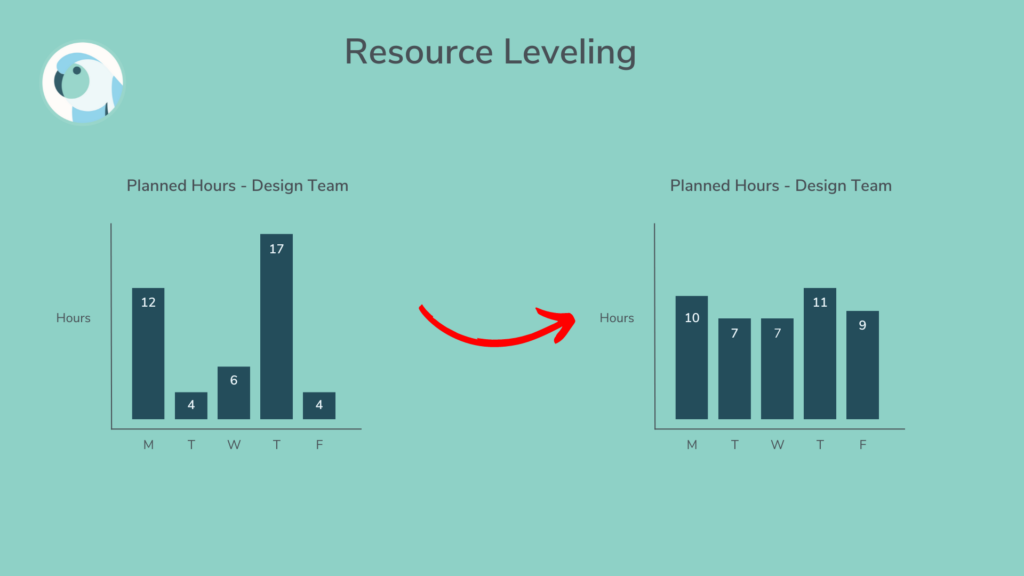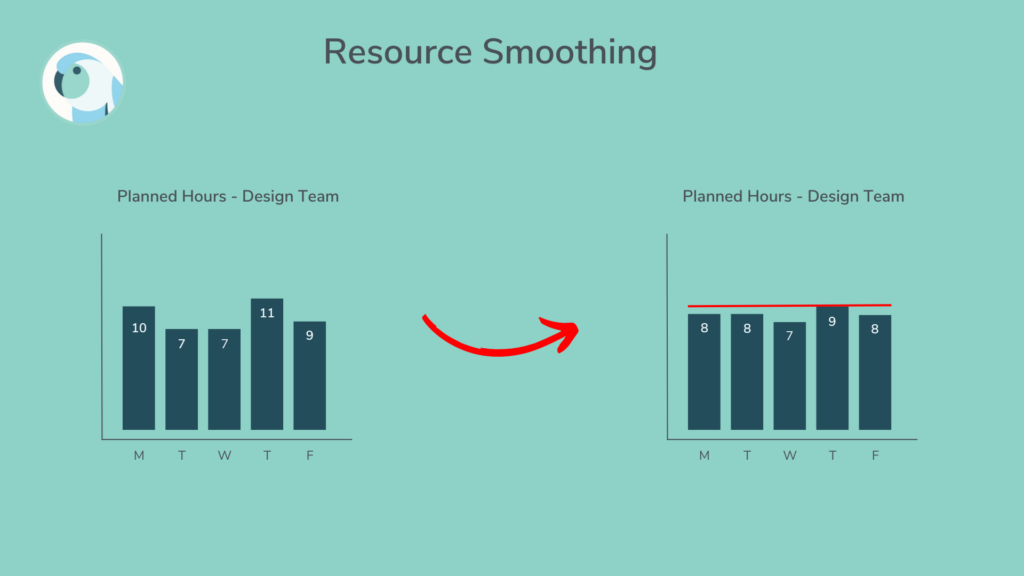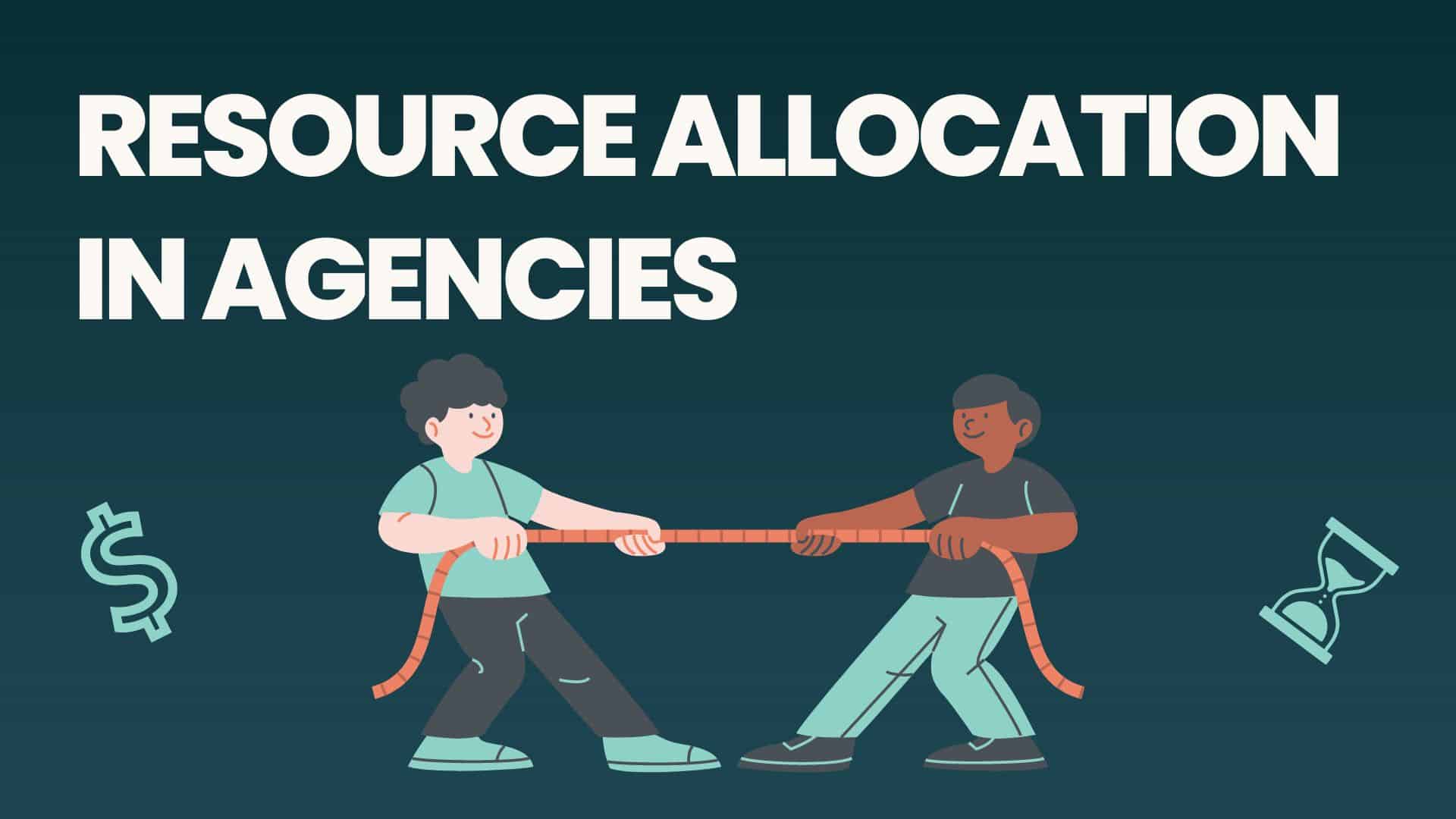Welcome to an overview of Resource Allocation – a 101 class of dos and don’ts, for those just getting started.
What is Resource Allocation?
Resource allocation in an agency is the process of distributing available resources, mainly budgets & people, to different projects or tasks. It’s about making smart decisions to use resources effectively and efficiently so that you and your team are on track towards your goals. This involves assessing priorities, analyzing project needs, and assigning resources accordingly. Effective resource allocation ensures optimal utilization, minimizes waste, and maximizes productivity. It does all this while also making work less stressful for the team, by creating clarity and forward visibility into what they’ll be working on and when, and helps you avoid over-allocating the team. It requires careful planning, coordination, and monitoring to maintain a smooth workflow and achieve objectives within the given constraints.
Importance of Proper Resource Allocation
Effective resource allocation is essential not only for agencies to achieve their objectives but to support those who have dedicated so much of their time and energy towards the common goal. By carefully managing available resources, such as budgets and team, agencies can optimize their operations, minimize waste, and ensure responsible resource management. The flexibility to adapt and adjust resource allocation allows agencies to respond to changing circumstances and seize opportunities as they arise. Proper resource allocation is a key factor in enhancing overall performance and achieving success in a resource-constrained environment.
Types of Resources
The main sources that need to be effectively distributed in a given project are human resources (your team), financial resources (your money) and related – your time. There is a fair argument to have a longer list, but for simplicity’s sake, let’s keep it short.
Bottom Up vs Top Down Resource Allocation
Before we go any further into this post, a quick distinction needs to be made between two different approaches of divvying up resources at your agency.
The Top-Down resource allocation method is where you’ll use high level estimates about projects, informed by historical data, to estimate the time required to complete a project in broader, more abstracted terms. For example, you might estimate hours by role or task category, (20 hours of the Design team, and 2 hours of the Accounts team). Add these up across a period of time, and you’ve got an idea of what the future looks like. This methodology is particularly useful when trying to forecast broader time horizons (several months) and/or when trying to forecast things that are uncertain, and likely to change over time (projects that are still in the sales pipeline, or different hiring scenarios). It’s meant to be quicker and more frictionless to allow for more nimble forecasting that is less precise but still accurate and useful.
Working with Parakeeto will eventually give you access to detailed capacity reports like in the example below:

This post however, will be focused more on Bottom Up Forecasting which is the approach of breaking down a project into smaller tasks and assigning them to each person on the team to do. It’s very precise, but it’s more of a short term method as it can be difficult to maintain as problems or changes arise, or for a longer term projection. This strategy is best used for more “mature” sets of data, such as projects that have already been confirmed and scoped, and more rigid staffing plans. It’s typically a process used by project management and delivery teams to get detailed insight into who will be doing what over a short-term time horizon (days or weeks).
Benefits of Effective Resource Allocation
Effective resource allocation at your organization has a ton of tangible benefits and intangible benefits. Here are some noteworthy ones:
Improved Project Efficiency
By strategically assigning the right people to the right tasks and distributing resources evenly, agencies can maximize productivity and prevent bottlenecks. This ensures that projects are completed on time and within budget, optimizing overall performance.
Clarity and Focus for the Team
By having a plan into the future, you’re giving your team clarity into how their time is going to be spent as well. They know which projects are going to land, when to land them, and so on. They’ll also know when a busy week is coming, or when the upcoming week is a light one. Knowing helps!
Less Stress and Overtime Work
Of course, a huge benefit to a solid resource plan is that your team won’t be stressing and working overtime hours. As mentioned above, you may have busy weeks, but knowing ahead of time will help you plan, shift work around and get the job done. The last thing your team wants is a surprise all-nighter.
Enhanced Cost Management
With more efficient projects comes more applicable and pointed spending. By preventing overallocation, maximizing resource efficiency, and making informed choices, agencies can achieve cost savings, making the time it took to get there worth it.
Increased Team Productivity
It also helps in boosting productivity. By assigning the right people to the right tasks, streamlining workflows, and managing time effectively, agencies and people can focus their efforts where they matter the most (and in many cases, where they feel most comfortable to focus!)
Competitive Advantage
By optimizing resource allocation, agencies can put themselves in a situation where they’re more agile and able to adapt quickly to market changes and customer demands. This in turn ensures that you’re a step ahead of the competition.
Reliability for your Clients
Naturally, a smooth project also benefits your clients. They’ll get the promised services on time, at the quality they need because your team has the time and resources to deliver it successfully. There is a domino effect here!
Tools and Techniques for Effective Resource Allocation
Here are some tools you can make use of to level up your resource allocation game.
Keep It Simple
Arguably the most important technique we can offer, from our insight into hundreds of agencies, is to keep it simple. No matter how you plan on allocating your resources down the road to reap the benefits, the number one piece of feedback we can give is to avoid super complex, tedious, redundant processes that add friction and unnecessary complexity to your resource allocation system. The best resource management system is the one you actually use, and keep updated regularly. Keep it simple, and you’re more likely to maintain resource plans over time and therefore have more accurate data to make decisions from.
Pssst – when it comes to installing a cadence to have regular reviews of your resource plan, you’re going to need the free meeting template found in the Agency Profit Toolkit. It comes with all of the spreadsheets, templates and training videos that you’ll need to take your resource planning game to the next level. Get it below!
Project Management Software
Making use of software is one of the first ways we’d recommend you to do when trying to implement a better resource allocation process. Some of these tools are more focused on resource planning, while others are PM tools first, that have resource allocation features built-in.
A few noteworthy “purist” tools, in that they’re set up specifically for Resource Allocation are:
- Float
- Runn
- Toggl Plan
- Harvest Forecast
- There are many more where these come from.
On the PM tools that have resource allocation features:
When selecting a tool, the most important thing to remember is that the best tool is the one that your team actually uses. Your resource plan is only as good as the data you put into it, and is only as timely as your cadence for updating it. Look for something that plugs into your workflow and reduces the friction of keeping things up to date. Many of these platforms can help reduce the friction of building and maintaining effective resource plans, and make drawing insights out of that plan easier compared to using spreadsheets or other more manual methods.
Resource Leveling

Resource leveling is another tactic you can use to allocate resources effectively. It’s the technique of adjusting timelines or project schedules to eliminate peaks and valleys in resource demand, usually done by shifting task start dates, adjusting task durations, or rescheduling project activities. The objective is to avoid resource overloads or underutilization by redistributing work more evenly over time.
Resource Smoothing

Similar to the above, where resource leveling focuses on adjusting timelines, resource smoothing aims to achieve a consistent resource utilization rate by adjusting the resource availability or capacity. It involves adjusting the availability of resources, in many cases implementing maximum capacities in a given period of time, to maintain a more constant resource demand, reducing fluctuations and avoiding sharp resource peaks or valleys. This is portrayed by the red line in the above image.
Timeboxing
Another fairly well-known technique is timeboxing. You can do this by setting aside time for specific blocks of work, allowing you to naturally prioritize and focus on the task at hand. prioritizing tasks, promoting efficiency, enabling effective resource planning, fostering. It also comes with a built-in flywheel, in that if you cannot complete your task in the allotted time, clearly either the task needs to change, or the amount of time you need to complete it can.
Overcoming Common Resource Allocation Challenges
Here are some of the most common challenges that agency folk are faced with these days, and how to work around them.
Precision vs Accuracy
For those of you who have practiced resource allocation in the past, this one’s for you.
If you create an incredibly detailed resource allocation plan, you may think to yourself “I’m going to have the most accurate system, allowing for great data-backed decision making” which, in theory would be great, but in reality you’re setting yourself up for failure. A complex, overly granular resource allocation plan will add friction for you/the team to meet expectations, and sometimes are so detailed that they’re impossible to manage consistently, actually leading to less accurate feedback from the data than if you had installed a more simple system.
The point is, that more precision doesn’t always mean more accuracy. Keep it simple.
Managing Resource Constraints
Once you’ve sold the work, you’re going to have to deliver it for your clients. But one common issue is that your team is already stretching themselves thin.
To manage these restraints, you’ve got a few levers you can pull:
- Pushing back timelines
- Pulling in resources from other teams/departments
- Deprioritizing internal or non-urgent tasks
- Pulling in resources from external sources (freelancers, contractors)
If you’re in a situation like this, short term, another option is to slow down your pipeline to allow the team to catch up. But at a deeper level, you might want to evaluate your Delivery Margin to ensure the ratio of profit you’re keeping from each dollar of revenue you earn is healthy. It’s also possible that there needs to be a better top-down forecasting approach in order to get visibility into resource constraints further ahead of time, which bottom-up resource planning will generally not be well suited to do (the ship has often sailed by the time you’re assigning tasks to the team for the next few weeks).
While bottom-up resource planning can help you navigate instances where the team is overbooked or a project scope blows up, it is often not well suited towards diagnosing and fixing systemic profitability and scope creep challenges.
The best way to get to the root-cause of those problems is to zoom out and understand fundamental profitability metrics and install top-down forecasting and feedback loops. This is the kind of stuff we specialize in at Parakeeto.
Handling Competing Priorities
To handle competing priorities, you can start by assessing your overarching objective. Which task/project is serving us and taking us closer to the end goal?
Aside from this, consider current resource availability and make reasonable trade-offs to strike a balance for you and your team.
Dealing with Changing Project Scopes
Project scopes slipping away from the original plan is (unfortunately) common and to be expected from time to time. To deal with this, develop a robust onboarding/expectation setting process, build contingency plans, and continually monitor project progress.
Moreover, ensure your agency is a place where communication and agility are core to everything you do. That will in turn help with the inevitable fact that scopes can change.
Sometimes, a scope change will be instigated by the client which opens up the conversation for negotiating on timelines or budgets to help absorb the additional work.
Best Practices for Resource Allocation
Here are some core concepts that you can apply to your own resource allocation system to run a smooth operation.
Establishing a Resource Allocation Process
The process by which you divvy up resources to complete projects at your agency will be key for consistency, reliability and stability. By following a step of steps, you’ll be able to divvy work, reflect on its precision/outcomes, and tweak from then on. Without consistency, you’ll be all over the place. Probably the most important part of this process is establishing a consistent cadence on which resource plans will be reviewed and updated. A weekly cadence is a good starting point for those installing this process for the first time.
It’s also important to be consistent internally with things like delivery hour allocations and targets, task time-estimates, and other aspects of how data is modeled in a resource plan.
Encouraging Cross-Functional Collaboration
By using downtime at your agency to create a cross-functional team, you’ll be able to keep a more consistent utilization rate across the team. This can be done by making an effort to keep a group of team members up to speed on certain service offerings, or by hiring team members with multiple skillsets. Keep everyone “able” to hit the ground running when a project sells-– no matter what kind of project it is.
Promoting Proactive Communication Among Team Members
Keeping tabs on your team members can be difficult, especially as you grow and scale. By fostering an environment where team members feel comfortable reaching out to you and other members for help, you’ll always know who needs what, when. Not to mention, this communication will provide team members with teaching/learning opportunities, therefore making your team even more cross functional. It’s critical that team members feel comfortable calling out when they feel that their work plan is unrealistic, or may not get done so project managers have the ability to look around corners and mitigate risk. Especially when there are dependencies between tasks, allowing the team to feel safe in calling these things out can be the difference between hitting and missing critical deadlines.
Regularly Reviewing and Updating Resource Allocation Plans
The first step to effective resource allocation is to try. By trying, you’re at least dividing up resources and setting team members on their way to get a project done. The second and arguably more important step is the retrospection that happens afterwards. For this project, did I give our team members enough time to complete it? Did they have the budget they needed? What about the timeline?
By regularly holding retrospective meetings, you can see trends in resources needed for specific departments/projects and use that to inform future projects.
Account for Non-Delivery Time
Often, we want to allocate our team to an arbitrary utilization target without taking into consideration things like internal responsibilities they have, time off, holidays, company events, and other things that will take away from their available time to complete client work.
Considering these things can help us identify risks and opportunities for reprioritization so we avoid putting client projects at risk and overworking our team.
Conclusion
In conclusion, effective resource allocation is crucial for agencies to achieve their goals and optimize their operations. By strategically distributing budgets, people, and time, agencies can enhance project efficiency, improve cost management, increase team productivity, and gain a competitive advantage. Utilizing tools such as project management software, resource leveling, resource smoothing, and timeboxing can greatly aid in the resource allocation process. However, agencies must also address common challenges such as over-precise resource allocation processes, handling competing priorities, and dealing with changing project scopes. Implementing best practices, including keeping things simple, establishing a process, encouraging cross-functional collaboration, and regularly reviewing and updating resource allocation plans, can lead to a smooth operation and continual improvement.
By consistently assessing and adjusting resource allocation based on retrospective analysis, agencies can optimize their resource utilization and achieve long-term success in a resource-constrained environment.





0 Comments